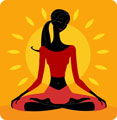
The Way It Makes You Feel
It always amuses and surprises me how kakasana (crow) is capable of eliciting a myriad of reactions from the students. Last week, as the vinyasa sequence drew to a close, I beamed at them and announced, "And now for your favourite pose. The crow."
Some chuckled.
Some sighed.
Some rolled their eyes.
Some fiddled with their clothes.
None moved.
After a generous sprinkling of enouraging words and pointers, they reluctantly pushed their palms onto the mat and hesitantly raised their rear ends. For the next few minutes, the studio was reverberated with thuds, thumps, frustrated mutters and annoyed groans. Despite me repeating that the effort mattered more than the result, they remained entrenched in their pursuit for perfection. Naturally, they fell short of their own expectations.
After the class, J approached me, a frustrated frown still etched above her brows and a deep desire to know exactly why she couldn't stay in the pose for more than a second. We worked on her alignment for a while and she soon understood what she needed to do. As she rolled up her mat, she suddenly turned to me and said, "But what does it feel like? I think if I knew what it feels like I could do it."
For a moment, I didn't know what to say. No one had ever asked me that before. How do you explain what a pose feels like? Weightless? Graceful? Strong? Gravity-defying? Would she understand how it felt if I described it that way? I doubted it. So I told her, that how it feels would be up to her.
The emotions that emerge from achieving a pose depends on your perception of it and your approach towards it. If you think sirsasana (headstand) signifies power and superiority, then you would only be aware of your swelling ego when you're finally upside down. If you approach paschimottanasana (seated forward bend) with gritted teeth, then you will feel triumph when your chin finally touches your knees. And if you are completely relaxed when you fold over into halasana, you will feel peace when your toes touch the floor.
No asana comes with a list of specific emotions. Instructions and benefits yes, but never emotions. That is for the practitioner to discover in his or her journey into the pose.
That is the beauty of yoga.


2 Comments:
I approach kakasana with a "you-want-me-to-do-that?!" attitude which probably explains why its one of the few poses that I haven't been able to come close to achieving. I understand J's question though - how is it supposed to feel physically? I hear its more a pose of balance and fearlessness than anything else which has since inclined me to get my butt higher in the air but the possibility that my face may land splat on the mat is not a welcoming thought.
But yes, its true what you say - that how you approch a pose effects how you feel when you get into it - often I feel dfferent things depending on the kind of day I've had.
Still, that is a great picture you posted though.
you're right, kakasana is about balance and fearlessness. and it's also about allowing yourself to fall on your face (assuming there's a cushion underneath) too. once you've fallen, the fear of falling is usually either lessened or gone completely.
but you made me realise something. i had assumed that J was talking about emotions rather than a physical feeling. hmm.
Post a Comment
Subscribe to Post Comments [Atom]
<< Home